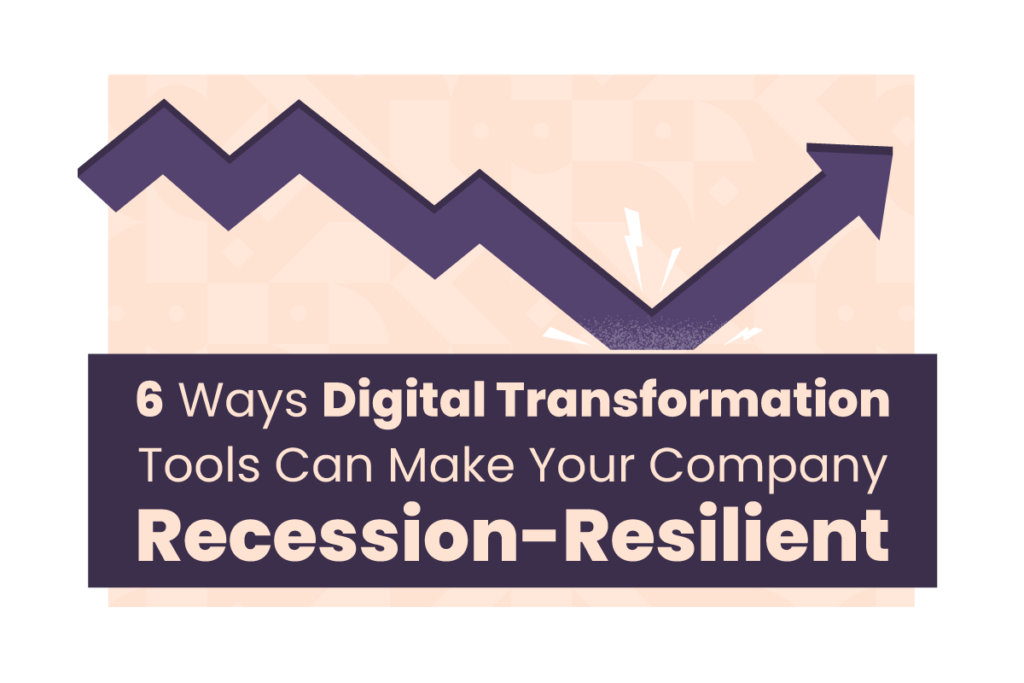There’s an economic storm coming.
The problem is that nobody can predict exactly where it will hit, how long it will last or what kind of damage it will do.
Every financial expert has their own opinion. One says the sky is falling and another advises us to keep calm and carry on. Deciding who to believe can be overwhelming.
But here’s the thing, there’s always a storm coming.
The global economy has always been, and always will be, unpredictable.
Sometimes it’s just a wild market fluctuation. Sometimes it’s a global health crisis that triggers bigger problems like supply chain disruption and workforce shortages.
Other times it can be a full-blown recession.
Nobody knows for sure until everybody knows.
So instead of trying to guess exactly what’s coming, sometimes the best strategy is to keep moving forward and prepare for the worst.
Nothing has the power to move you forward faster than investing in digital technology.
The hard truth about “recession-proof”
The most successful companies in the world stay afloat and thrive because they’ve learned how to navigate rough waters.
And they know there is no such thing as “recession-proof.”
During times of economic uncertainty, there are a million factors we cannot control. Materials costs. Fuel prices. World politics.
The best strategy is to focus on what you can control, which is your company. Your people. Your process.
There’s no doubt that technology can help.
A 2021 Digital Transformation Executive Survey from Deloitte found that “more digitally integrated organizations measurably outperformed on their strategic objectives, capacity to change, and ability to win.”
Embracing digital innovation can mean the difference between merely surviving a recession and coming through it even stronger.
But technology is not magic. There’s no single app or device powerful enough to make your business immune to the effects of wide-scale financial disruption.
The good news? While digital innovation won’t make your company recession-proof, it can make it “recession-resilient.”
Learn how to bend without breaking
In 1906, a massive earthquake rocked San Francisco and destroyed over 80% of the city.
That disaster spawned an engineering challenge that continues to this day: How do you design and construct buildings that will bend without breaking?
While no building is 100% earthquake-proof, advances in materials and technology have led to structures that are more resilient and safer than any other time in history.
Instead of falling apart, the buildings sway and bend to absorb some of the seismic shifts. They remain flexible in the face of massive shock and disruption.
Adopting and integrating new technologies can do the same for your company. It can help you bend without breaking.
This is especially important since the National Bureau of Economic Research defines a recession as “a significant decline in economic activity spread across the economy, lasting more than a few months.”
We’re not talking about battening down the hatches for a quick storm. Economic downturns have been known to drag on for a while so it’s important to plan for the long haul. And to make matters even worse, there’s always another financial disruption waiting around the corner.
That’s why it might make more sense to simplify your “recession strategy” by just calling it your strategy.
Invest in digital transformation tools to change the way you work
Change is hard.
Some companies don’t see the logic in dealing with outside change (recession) by making big changes inside (innovation). They want to avoid risk as much as possible by staying the course.
But research shows high-performing companies understand that the best way to manage both risk and change is with a plan. A plan that’s equal parts defense and offense. A plan that cuts spending and strategically invests.
A plan that leverages the latest technology to help them speed back up once the slowdown is over.
Research from McKinsey shows that in addition to clarifying goals and empowering their workforce, high-performing companies spent more money on collaboration technologies.
According to the article, “These companies found that they could quickly shift the business model: in a matter of weeks, they routinely built new products and services or pivoted entire operations from in-person to remote, adapting to consumer preferences and practical reality—all actions that might have taken a year in the before times.”
Even amid economic uncertainty, technological innovations continue to evolve. Artificial intelligence gets smarter every day. Networks grow and get stronger.
And more companies are realizing that embracing new digital tools to help them work smarter is no longer considered a bold or risky move. It’s become a necessity.
A survey from PwC shows that:
- 53% of executives are increasing investments in digital transformation
- 48% of executives are increasing investments in customer experience
- 63% of businesses have changed or are planning to change processes to address labor shortage
If you’re still not convinced, here are some concrete examples of how digital transformation tools can encourage growth and build resiliency…
1. They Reduce Waste
Tough economic times usually mean slower sales and less cash flow. While companies race to find new and better ways to bring more revenue in, they can also save big by focusing on cutting the cost of inefficient operations.
The right digital tools can help you locate and repair financial “leaks.” Tracking and measurement tools can identify where waste is occurring and help optimize processes to reduce or eliminate it.
2. They Improve Customer Experience
Today’s customers demand convenience. They want (and need) problems solved with a few clicks, swipes or scans. Every hoop or hurdle you put between them and a solution gives them an excuse to go somewhere else.
Agent-assisted and self-guided digital workflows can help streamline the customer experience and create easy routes to a first-time fix. Visual customer service support can build empathy, improve communication and help grow trust.
3. They Increase Process Efficiency
Year after year, companies strive to do what they do better. Faster. At a lower cost. With higher quality.
Efficiency is the never-ending mission that can benefit most from new digital technologies.
Process automation tools can boost productivity by eliminating time-consuming and repetitive tasks. Those built with AR and AI capabilities add even more value and help keep optimization a top priority.
The trick here is to remember that the best automation solutions are powered by people. As stated by PwC, “Without the right talent, automations can fail to deliver on promised efficiencies and increase operational risk.”
The added bonus? Companies with leaner and more nimble operations have a distinct advantage once the economy settles.
4. They Boost Employee Satisfaction
Nobody comes to work hoping to leave frustrated. Regardless of their title, people want to win at their job.
They want to solve a customer problem, fix a faulty machine, or help someone file an insurance claim after an accident. Falling short feels terrible.
Tools that help service teams solve problems faster do more than boost the bottom line. They give your workforce the satisfaction of a job well done… and a job done right the first time.
It doesn’t hurt that those tools also allow them to offer a more enhanced level of service, retain more mission-critical data and help more people in less time.
5. They Expose New Revenue Opportunities
Digital innovation has the power to help you see what you do in a whole new light.
One of the biggest trends for manufacturers is the idea of offering more than a product. Servitization prioritizes outcomes and performance over products.
Instead of simply buying a piece of equipment, the customer engages in a long-term relationship with the manufacturer based on service and continued support.
Digital innovation and the Internet of Things (IoT) are helping to make this a profitable shift for manufacturing companies around the world.
6. They Support Sustainability
It’s not enough to focus on results for the short term.
Customers, employees and investors are counting on you to stick to long-term plans that keep future generations in mind. Even during a recession, companies need to stay committed to sustainability.
We’ve all experienced how digital transformation can immediately impact the environment. During the peak of the COVID-19 crisis, shutdowns across the globe led to improvements in air quality and reductions in water and noise pollution.
With many employees working remotely from home, companies were forced to improvise using digital tools such as video conferencing and online collaboration software.
Businesses have made their way back to normal, but new research shows that about one-third of work in the United States is still being done from home. And numbers from the UK indicate that 84% of workers forced to work from home because of coronavirus said they planned to stick with a hybrid work model for the future.
And because so many companies relied on basic visual tools then, they’ve been quick to see the value of video as part of a “remote first” strategy today. Much more advanced visual support tools are helping them elevate the capabilities of their customer service and field service operations.
The remote-first approach also gives them an almost unfair advantage when it comes to meeting their sustainability goals.
Work from Home (WFH) options reduce or eliminate employee commutes. Digital solutions don’t waste paper. And fewer truck rolls mean less fuel usage and lower carbon emissions.
Resilience is a Team Sport
They say that the secret to success is just getting started.
But sometimes building (and maintaining) momentum can be the hardest part.
Digital transformation is not a magic bullet or a miracle diet. It’s a process that needs to be built into the fabric of your company to ensure future growth.
An article from McKinsey about major oil and gas companies showed that while most of them launched a digital transformation effort, as much as 70% of them haven’t progressed past the pilot phase.
What’s stopping them from moving forward?
Every company can probably come up with a million reasons why their digital innovation got stuck. But there’s only one good reason to get unstuck: your company’s future.
Businesses who make it through the coming round of economic turbulence might not have much recovery time before the next wave hits. According to the International Monetary Fund (IMF), there were 122 completed recessions in 21 advanced economies between 1960 and 2007.
That’s a pretty steady diet of disruption.
In 2019, Walter Frick wrote an article in the Harvard Business Review where he observed that “Recessions can create wide and long-standing performance gaps between companies.”
He added, “Research has found that digital technology can do the same. Companies that have neglected digital transformation may find that the next recession makes those gaps insurmountable.”
You can see why preparing for tough times deserves top priority. And since none of us can go back to yesterday, starting today is the next best option.




